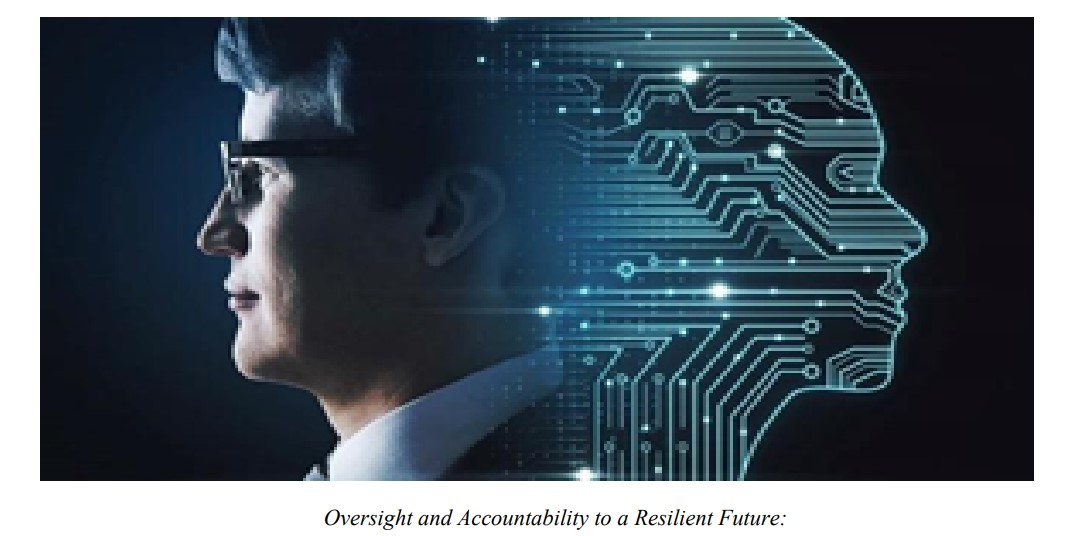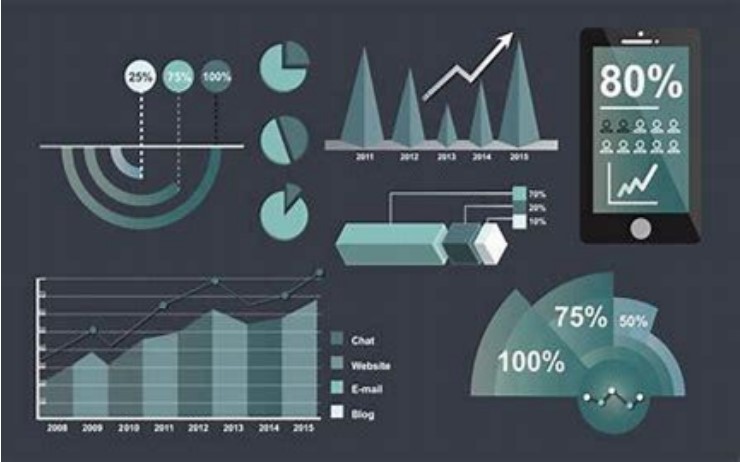
Ms. Taiba Mohammad Al-Shammari,
Associate Auditor in the State Audit Bureau Kuwait

As we stand on the brink of a digitally transformed world, technologies like Artificial Intelligence (AI), Machine Learning(ML), advancedanalytics, anddata analytics are rapidly reshapingtraditional industries, (KPMG, 2024) and as global risks and regulatory demands grow more complex, internal audit functions are transforming from traditional compliance roles into integral parts of risk management and strategic oversight (Deloitte, 2024). One domain undergoing profound transformation is internal auditing, where these technologies are now leveraged to enhance risk management, ensure robust oversight, and secure resilience in today’s volatile business environment. Globally, leading firms have begun harnessing the power of digital tools and AI-driven insights to refine and strengthen audit processes, aligning them with the demands of a dynamic, interconnected world (ISACA, 2024). This shift represents not only an operational evolution but also a strategic realignment, marking a new era of audit intelligence that combines precision with proactive risk mitigation.
In Kuwait, which is keenly focused on economic diversification and resilience under Vision 2035 “New Kuwait,” (Khatib, 2024) this transformation presents substantial opportunities. By integrating advanced analytics, AI, and centralised digital platforms into internal audit practices, Kuwaiti institutions can reinforce governance frameworks, elevate compliance standards, and build a foundation for sustainable growth (Microsoft, 2019). This approach not only improves internal oversight but also positions Kuwait as a regional leader in data-driven governance, attracting foreign investment and fostering a robust local economy. The future of internal audits hinges on adopting these pioneering technologies, moving towards a more data-centric, automated audit landscape will aid Kuwait's organizations to achieve enhanced accountability, robust oversight, and greater operational agility (William, 2024). By integrating AI and ML into its audit frameworks, Kuwait can advance its risk management strategies, enabling more proactive identification of vulnerabilities and enhanced resilience against market and operational challenges. Such integration is not merely an ambition—it is a necessity to keep pace with the evolving global landscape, safeguarding Kuwait's economic and strategic interests (OXFORD BUSINESS GROUP, 2024)
This article delves into the transformative potential of AI, ML, and data analytics within Kuwait’s internal auditing sector. Our goal is to outline the crucial steps required to implement these technologies successfully, building a forward-thinking foundation that places Kuwait on par with global best practices. In doing so, we will explore:
- 1. The Global Transition to AI, ML and Technology: Analyzing how global leaders in auditing have adopted AI, ML and advanced analytics, setting a benchmark for Kuwait.
- 2. Key Areas for Kuwait’s Audit Transformation: Identifying the essential components needed to adapt Kuwait’s auditing frameworks.
- 3. Data Analytics: Establishing a strong foundation for data-driven internal audits that enhance accuracy and transparency.
- 4. AI-Powered Risk Assessments: Revolutionizing Kuwait’s approach to proactive risk management with AI-enabled strategies.
- 5. AI Governance and Ethics: Building ethical frameworks that ensure AI is utilized responsibly within Kuwait’s auditing systems.
- 6. The AdvAnCE Platform: Exploring a comprehensive, centralised digital solution tailored for Kuwait’s internal audit needs.
- 7. Generative AI in Practice: Real-world applications of generative AI to enhance efficiency, accuracy, and insights within Kuwait’s audit processes.
- 8. Implementation Roadmap for AI and ML in Kuwait’s Public Sector Auditing
- Adnovum. (2024, March 19). Enhancing Audit Efficiency with Centralized Systems in IT Compliance. Retrieved from Adnovum: https://www.adnovum.com/blog/enhancing-audit-efficiency-with-centralized-systems-in-it-compliance
- Agrawal, K. (2024, July 15-17). AI-Powered Insights: Revolutionizing Risk Assessments in Internal Audit. IIA International Conference 2024. Washington D.C., U.S.A: IIA.
- Bellec, A.-C. (2024, 2 28). opendatasoft. Retrieved from opendatasoft: https://www.opendatasoft.com/en/blog/how-self-service-data-powers-data-centric-public-sectororganizations/
- Bouchot, M. (2022, 11 22). Why The Public Sector Needs Data Governance. Retrieved from alation: https://www.alation.com/blog/public-sector-data-governance/
- D&B Bureau. (2019, 4 2). Kuwait Vision 2035: the rising of a “New Kuwait”. Retrieved from Diplomacy & Beyond: https://diplomacybeyond.com/kuwait-vision-2035-the-rising-of-a-new-kuwait/
- Deloitte. (2024). Navigating the artificial intelligence frontier. Retrieved from An introduction for internal audit: https://www2.deloitte.com/us/en/pages/advisory/articles/artificial-intelligence-for-internal-audit.html
- Ekendahl, K., & Coady, V. (2024, July 15-17). The Global DEI Landscape: Auditing Across Cultures. IIA International Conference 2024. Washington D.C., U.S.A: IIA.
- Findlay, R. (2024, July 15-17). Data Analytics The benefits of developing from basic analytics to AI. IIA International Conference 2024. Washington D.C., U.S.A: IIA.
- Government Accountability Office (GAO). (2021, 6 30). ARTIFICIAL INTELLIGENCE. Retrieved from An Accountability Framework for Federal Agencies and Other Entities: https://www.gao.gov/assets/gao21-519sp.pdf
- Grimmelikhuijsen, S. (2022, 6 8). Fostering trustworthy AI in the public sector. Retrieved from AI Watch: https://ai-watch.ec.europa.eu/system/files/2022-06/Trustworthy%20AI%20in%20the%20public%20sector %20EC.pdf
- ISACA. (2024). Deloitte Business Advisory Sdn Bhd. Retrieved from How do Analytics and Automation Transform Audit Practices: https://www2.deloitte.com/content/dam/Deloitte/my/Documents/audit/my-aud-how-doanalytics-and-automation-transform-audit-practices.pdf
- Khatib, H. (2024). Economic diversity in Kuwait between “Vision 2035” and reality. Retrieved from Middle East Economy: https://economymiddleeast.com/news/vision-2035-kuwait-economy/
- KPMG. (2024). Transforming internal audits through the power of AI. Retrieved from KPMG LLP: https://kpmg.com/us/en/articles/2024/transforming-internal-audits-power.html
- Leocádio, D., Malheiro, L., & Reis , J. (2024, 9 2 8). Artificial Intelligence in Auditing: A Conceptual Framework for Auditing Practices. Retrieved from MDPI: https://www.mdpi.com/2076-3387/14/10/238
- Levy, M. (2024, July 15-17). Cyber Risk Assurance Enhancing Internal Audit's Role in Cybersecurity as Consultants and Advisors. IIA International conference 2024. Washington D.C., U.S.A: IIA.
- Microsoft. (2019, 11 13). CAIT partners with Microsoft to upskill Kuwait’s government sector workforce and accelerate digital transformation. Retrieved from Microsoft News Center:
- https://news.microsoft.com/en-xm/2019/11/13/cait-partners-with-microsoft-to-upskill-kuwaits-government-sectorworkforce-and-accelerate-digital-transformation/
- OXFORD BUSINESS GROUP. (2024). Increased investment in Kuwait ICT improving public and private sector outcomes. Retrieved from https://oxfordbusinessgroup.com/reports/kuwait/2022-report/ict/greater-connectivity -local-and-foreign-investment-in-technology-has-resulted-in-improvements-in-the-public-and-private-sectors/
- Simos, M. (2024, 10 30). Generative AI is reshaping security risk. Zero Trust can help manage it. Retrieved from CSO: https://www.csoonline.com/article/3595580/generative-ai-is-reshaping-security-risk-zero-trust-can-help-manage -it.html
- Stepanyan, K. (2024, July 15-17). Navigating Regulatory Reporting Storms: Unraveling Cybersecurity Challenges for CISOs, CIOs, CTOs and CAEs. IIA International Conference 2024. Washington D.C., U.S.A: IIA.
- Thomson Reuters. (2021, July 8). Statutory Reporting. Retrieved from Technology is Enabling Centralized Global Statutory Reporting: https://tax.thomsonreuters.com/blog/central-global-statutory-reporting/
- Veghini, L. (2024, July 15-17). AdvAnCE Strengthen Oversight Today, for a Safer Tomorrow. IIA International Conference 2024. Washington D.C., U.S.A: IIA.
- William. (2024, 8 16). Kuwait Artificial Intelligence | Exploring the Future of a Digital Powerhouse. Retrieved from techwelo:https://techwelo.com/kuwait-artificial-intelligence/
- Workiva. (2024). Generative AI in Internal Audit: Practical Application for Audits with Example Prompts. Retrieved from Workiva: https://www.workiva.com/blog/generative-ai-internal-audit-practical-application-audits-example-prompts
Through these explorations, we aim to provide a roadmap for building a resilient, digitally empowered future for Kuwait’s auditing sector—one that not only meets but exceeds the global standards of governance, risk management, and accountability.
The Global Transition to AI, ML and TechnologyIn the wake of rapid technological advances and the global transition to AI-powered auditing, global leaders in auditing are embracing AI and advanced analytics to redefine traditional audit practices, setting a high standard for countries like Kuwait as they seek to enhance public sector oversight. ML has emerged as a cornerstone, enabling auditors to identify and predict risks with unprecedented accuracy. ML algorithms can analyses vast datasets to identify patterns, anomalies, and trends that may signal fraud or operational inefficiencies. For instance, machine learningmodels usedby firms likePwC and KPMGfacilitate continuousmonitoringoffinancial transactions, enabling real-time anomaly detection that supports proactive auditing instead of traditional, periodic reviews (Government Accountability Office (GAO), 2021).
International audit firms and regulatory bodies, such as Deloitte and the European Union, have integrated AI to enable continuous, real-time monitoring of financial data, which vastly improves risk detection and operational compliance. For instance, Deloitte’s AI-powered audit tools support predictive analytics, allowing auditors to detect anomalies and forecast potential risks based on patterns identified in massive datasets (Leocádio, Malheiro, & Reis , 2024). Similarly, the European Commission emphasises trustworthy AI, which balances technological effectiveness with ethical safeguards like data transparency and privacy (Grimmelikhuijsen, 2022).

The U.S. Government Accountability Office (GAO) has also pioneered an AI Accountability Framework, detailing principles for AI use in government auditing, including performance monitoring and data quality. The U.S. GAO’s AI Accountability Framework includes provisions for the effective use of ML, stressing transparency, reliability, and the need for ongoing monitoring to mitigate bias (Government Accountability Office (GAO), 2021). The European Union has also highlighted the importance of explainable ML in public auditing to ensure that decisions remain transparent and accountable (Grimmelikhuijsen, 2022).
For Kuwait, adopting ML in auditing practices provides a clear pathway to achieving the goals of Vision 2035. By leveraging ML models, Kuwait’s State Audit Bureau could shift from reactive auditing to a proactive, predictive approach, identifying emerging risks and optimising resource allocation across the public sector. This shift could improve public trust and accountability while setting a benchmark for AI ethics and governance across the Gulf region (D&B Bureau, 2019).
Observingthesebestpractices, theState Audit Bureau (SAB)of Kuwait andother auditingentities can leverage AI to advance from traditional compliance checks to a more agile, data-driven approach that detects risks proactively. Adapting these frameworks would not only enhance transparency but also position Kuwait as a leader in digital governance, fostering a robust environment for foreign investment and sustainable economic growth. These global examples provide Kuwait with a roadmap for building a resilient, AI-enabled auditing infrastructure that aligns with international standards and prepares it to navigate the complex regulatory demands of the modern era. These models can be trained on historical data to “learn” risk indicators over time, helping auditors predict potential issues before they arise, which greatly enhances compliance and risk management strategies.
Data Analytics: Establishing a Strong Foundation for Data-Driven Internal AuditsData analytics has become indispensable for modern internal audit functions, allowing them to transition from periodic reviews to continuous monitoring. In Kuwait, data-driven audits are particularly valuable as they enhance transparency, support effective risk management, and help public and private sectors align with international standards. The use of AI in data analysis and pattern detection for proactive auditing is foundational in establishing a data-driven audit strategy that uncovers trends, streamlines processes, and strengthens compliance across sectors. Advancedtools likeAudit CommandLanguage (ACL) andPower Business Intelligence (BI) allow auditors tomanage and monitor large datasets effectively, spotting trends and enabling more efficient detection of irregularities that wouldotherwisebe missedin traditional audits.This aligns with the approachesdiscussedin the AI-PoweredInsights document, which describes automatic risk scoring and anomaly detection as key advantages in modern auditing (Agrawal, 2024). To advance its internal audit framework and align with both international standards and Kuwait’s national goals under Vision 2035, (GAO, 2021) the State Audit Bureau (SAB) can focus on several transformative areas.

Deploying Advanced Data Analytics Tools
Implementing advanced tools such as ACL, IDEA - Integrated Data Extraction and Analysis, and Power BI empowers internal auditors to analyse a vast array of data sources, from payroll systems to operational metrics, for inconsistencies or regulatory violations. For instance, in a government agency, data analytics can detect discrepancies in public expenditure, ensuring that funds are being allocated effectively and in accordance with Kuwait’s regulatory guidelines (Findlay, 2024). In financial institutions, these tools can identify irregular patterns in transaction data that could indicate fraud or compliance breaches, supporting Kuwait’s Anti-Money Laundering (AML) and Counter-Terrorism Financing laws (Agrawal, 2024).
Building Data Analytics CapacityBuilding a robust data analytics infrastructure requires both a skilled workforce and reliable technology. Kuwaiti institutions may face challenges such as a limited pool of analytics professionals and gaps in existing infrastructure. To address these issues, institutions should consider adopting several strategies, including specialised training programs, by offering workshops, certifications, and internships in data analytics and cybersecurity can create a skilled workforce that meets Kuwait’s evolving audit requirements (Findlay, 2024) Additionally, collaborations with technology providers where forming partnerships with analytics software providers ensures Kuwaiti organizations have access to cutting-edge tools, training and support for successful implementation.
Finally, fostering internal knowledge sharing through creating data-focused communities within organisations encourages ongoing learning and innovation in analytics practices, facilitating continuous improvement in audit quality.
With data analytics as a core component of internal audit, Kuwaiti organizations can improve efficiency, enhance compliance, and foster a data-driven culture that aligns with Vision 2035 goals (D&B Bureau, 2019).
AI-Powered Risk Assessments: Transforming Kuwait’s Approach to Proactive Risk ManagementAnother crucial domain is enhanced by AI-powered risk assessment, which shifts the focus from reactive to predictive risk management. Artificial intelligence represents a breakthrough in risk management, equipping auditors with tools to quickly analyse large data sets, identify patterns, and predict risks that may arise. In Kuwait’s regulated sectors, including finance, energy, and telecommunications, AI-powered risk assessments can help manage risks proactively, positioning organizations to address emerging threats before they escalate. By incorporating AI-driven insights, auditors can conduct continuous auditing, detecting patterns and identifying emerging risks in high-stakes sectors like finance and energy. The use of predictive analytics models allows auditors to focus resources where they are most needed, helping to manage risks more effectively and optimise strategic impact
How AI Enhances Risk Detection and ResponseAI-driven risk assessment tools enable continuous auditing, where data is collected and analysed in real time. For example, in Anti-Money Laundering (AML), AI can help financial institutions assess AML risks by automatically analysingtransactionaldata forpatterns that couldindicate suspicious activity, ensuringadherence tofinancial laws (Agrawal, 2024). Similarly, in Operational Risk Management in high-risk sectors, such as oil and gas, AI can analyse equipment data to detect anomalies that might indicate safety risks, reducing the likelihood of accidents and ensuringcompliance with international standards (Agrawal, 2024). Moreover, the implementationofPredictive Risk Models where AI algorithms can identify risksbasedon historicaldata, alertingaudit teams topotential issuesbefore they materialize, allowing for timely intervention.
By implementing AI-driven risk assessment tools, Kuwaiti institutions can shift from a reactive to a predictive risk management model, optimising resource allocation and supporting a more resilient operational environment.

To maximize the benefits of AI, it is essential to develop governance frameworks that outline ethical usage and ensure transparency. Effective frameworks involve crafting policies that set acceptable AI applications within audit functions, ensuring decisions align with organizational values by Establishing AI Policies. This can be done by creating policies that define acceptable AI usage in internal audit helps ensure AI-driven decisions are ethical and aligned with organizational values. Specialized AI training for auditors empowers them to utilize AI tools effectively, fostering skills required to deploy AI effectively and promoting understanding of both opportunities and limitations. Lastly, Building Cross-Functional AI Teams Collaboration between audit, IT, and risk management teams ensures AI is applied in ways that are ethical and compliant with both national and international standards (Agrawal, 2024).
AdvAnCE Platform: A Centralized Digital Solution for Kuwait’s Internal Audit NeedsThe AdvAnCE platform by Assicurazioni Generali is a benchmark in centralised digital audit solutions that consolidates risk data, streamlines analysis, and enhances management processes, providing a comprehensive system for risk data consolidation, analysis, and management. Developing a similar platform in Kuwait can provide a central framework for collaboration, risk assessment, and compliance monitoring across public and private sectors (Veghini, 2024).
Structuring a National Digital Audit PlatformA centralised audit platform for Kuwait could operate as a unified repository for risk data, accessible to various sectors like finance, healthcare, and government. This platform would serve multiple functions including automated data collection capabilities where Data from various departments or entities can be automatically gathered and stored in a centralized system, minimizing human error and ensuring data accuracy (Adnovum, 2024). Additionally, theplatform cangenerate real-time risk heatmaps that offer a snapshot of risk levels across sectors, which facilitates quick decision-making and resource allocation. Furthermore, this would support standardized reporting process to ensure that audits across sectors follow consistent methodologies andalign with Kuwait’s national andinternational standards, and international best practices, and thereby, fostering a unified approach to governance. (Thomson Reuters, 2021).
Cybersecurity Integration: Strengthening Kuwait’s Digital Defense through Internal AuditWith the rise in digital threats, a robust approach to cybersecurity within internal audit functions is critical. For Kuwait, particularly in critical sectors like finance, public services, and oil and gas, integrating cybersecurity into risk management is fundamental to building resilience. Internal audit functions can expand their role in cybersecurity by establishing comprehensive frameworks, evaluating incident response plans, and conducting cybersecurity maturity assessments (Veghini, 2024)
Expanding the Role of Internal Audit in CybersecurityInternal audit functions can play a proactive role in establishing cybersecurity frameworks, evaluating incident response plans, and guiding organizations through cybersecurity maturity assessments. This could involve implementing a cybersecurity framework by adopting international standards like NIST – National Institute of Standards and Technology or ISO 27001 tailored to Kuwait’s regulatory environment, enabling organizations to establish clear standards and guidelines for secure data handling (Levy, 2024). Additionally, conducting regular cyber maturity assessments allows auditors to evaluate the current cybersecurity posture of an organization, identifies vulnerabilities, and recommends improvements to ensure compliance and risk reduction. Internal audit functions alsobenefit from incident responseplanningandtesting,by conductingsimulations andresponsedrills, to ensure that an organisation’s cybersecurity measures are ready for real-world incidents, ensuring readiness and adherence to industry standards (Stepanyan, 2024).
Moreover, to ensure cybersecurity investments align with organizational risk tolerance, internal audit functions can evaluate the return on investment (ROI) on these investments, guiding decision-makers on a budget allocation that enhances both resilience and compliance. Auditors can recommend investments in areas that not only improve cybersecurity but also align with the strategic goals of resilience and compliance (Levy, 2024).
Furthermore, generative AI can introduce transformative potential by democratizing data access, enabling auditors and stakeholders at all organisational levels to engage in risk management directly. In Kuwait, implementing AI-driven tools across organisations allows auditors and stakeholders at all levels to participate in risk management, fostering a culture of transparency and accountability (Stepanyan, 2024).
Practical Applications of Generative AI in Internal AuditingGenerative AI can support a wide range of audit activities and practical applications within internal auditing, transformingtasks like engagementplanningandreportgeneration (Workiva, 2024). By analyzinghistoricaldata, AI suggests focus areas fother audits, enabling auditors to efficiently allocate resources and to identify high-risk areas that need more detailed review. Tools like Power BI and advanced analytics solutions support this proactive approach, streamlining the engagement planning phase (Veghini, 2024).
Likewise, report generation and summarisation where automated tools can draft preliminary audit reports allows auditors to focus on more strategic and complex analysis. Generative AI simplifies report generation by processing vast datasets and creating standardised summaries, which auditors can then review and refine (Bellec, 2024). This allows for faster, more consistent report production while freeing auditors to engage in high-value tasks. Additionally, the use of generative AI in engagement planning optimises resource allocation by pinpointing high-risk areas based on historical data, ultimately ensuring that audit resources are used where they are most impactful (Ekendahl & Coady, 2024).
Furthermore, enhancing accessibility through Self-Service Analytics, by adopting generative AI and self-service analytics, Kuwaiti public sector institutions can make data insights widely accessible, democratizing data analysis across all organisational levels. Self-service tools empower non-technical staff to access, interpret, and utilize data independently, fostering a data-driven culture that supports accountability and encourages informed decision-making. This approach promotes collaboration and enables various stakeholders to engage directly with data insights, driving greater alignment across departments and contributing to a transparent and proactive governance structure (Stepanyan, 2024).

Asuccessful integrationofAI, ML, anddata analytics within Kuwaiti institutions will require a structuredandphased approach to address potential challenges and maximize benefits. Here is a comprehensive roadmap to guide this transformation:
1. Developing a Comprehensive AI and ML Strategy
Kuwait’s institutions should initiate its AI and ML adoption with a well-defined strategy, aligned with Vision 2035 (Government Accountability Office (GAO), 2021). This strategy must set clear goals, designate responsibilities, and outline a roadmap that prioritises transparency, accountability, and compliance across all levels of public sector governance. Strategic objectives should include the adoption of AI and ML for improved risk management, resource allocation, and decision-making.
2. Investing in Talent Development and Specialized Training Programs
A critical step toward AI and ML adoption is developing a skilled workforce capable of handling these technologies. Collaborating with local universities, international educational partners, and technology firms, the institutions in Kuwait can establish comprehensive trainingprograms indata science,machine learning, anddigital ethics, ensuring that auditors possess the technical skills and ethical understanding needed to leverage AI responsibly and effectively (Bouchot, 2022).
3. Establishing Strategic Partnerships for Resource Acquisition
Building partnerships with leading AI technology providers and global audit organizations will ensure that institutions in Kuwait have access to the best available tools, technical support, and resources. Through these partnerships, Kuwaiti institutions can stay current with global best practices and integrate cutting-edge technologies tailored to the unique requirements of Kuwait’s public sector.
4. Building a Secure Data Infrastructure
A secure data infrastructure is essential to protect sensitive information in public sector audits. Kuwait’s entities must establish data governance policies and implement strong encryption, access control, and data privacy measures that comply with Kuwait’s regulatory standards. This infrastructure not only supports AI-driven audits but also builds public trust by ensuring that sensitive government and citizen data is handled securely (Simos, 2024).
5. Launching Pilot Programs to Test AI and ML Applications
Before scaling AI and ML technologies across all departments, the entities in Kuwait can introduce pilot programs in specific areas, allowing for controlled testing and refinement. Pilot programs help identify challenges, test data securityprotocols, andallow auditors togain hands-on experience with the tools. This measuredapproach helps the institutions in Kuwait develop a robust framework for broader AI integration and ensures successful, targeted adoption.
6. Implementing Continuous Monitoring and Ongoing Improvement Protocols
AI and ML tools require ongoing maintenance and regular updates to align with changing standards and audit requirements. Continuous monitoring and regular assessments of AI-driven tools allow the entities of Kuwait to optimize tool performance, maintain regulatory compliance, and ensure these technologies are always aligned with best practices. This commitment to continuous improvement ensures that Kuwait’s public sector remains resilient, adaptable, and capable of meeting evolving regulatory expectations.
ConclusionIn today’sdynamic andinterconnected world, the evolutionofinternal auditingandrisk management isbeingdriven by the adoption of advanced technologies like AI, ML, and data analytics. Kuwait’s focus on economic resilience and sustainable growth through Vision 2035 positions it at the forefront of this transformation. By embracing digital tools and adopting data-driven audit methodologies, Kuwaiti institutions, especially under the leadership of the StateAudit Bureau, canenhance their ability toproactivelymanage risks, ensure regulatory compliance, andfoster a transparent governance structure. Implementing a robust AI and ML strategy not only empowers auditors to make informed, proactive decisions but also aligns Kuwait’s public sector with global standards, bolstering the country’s reputation as a leader in data-centric governance.
A strategic, phased approach is essential to ensure the successful integration of these technologies, encompassing comprehensive training programs, secure data infrastructure, and continuous monitoring protocols. Initiatives like the AdvAnCE platform and generative AI applications demonstrate the practical benefits of digital transformation, supporting efficient engagement planning, automated reporting, and real-time risk management. With self-service analytics democratizing data access across all levels, these advancements are set to foster a collaborative, data-informed culture within Kuwait’s auditing and public sectors, strengthening oversight and accountability.
As Kuwait implements these changes, its internal auditing functions will evolve beyond traditional roles, becoming instrumental in safeguarding national interests and supporting sustainable development. By combining technological innovation with rigorous ethical frameworks and cybersecurity measures, Kuwait is not only preparing for current challenges but also building a resilient future capable of navigating the complexities of tomorrow’s global landscape. Through this digital evolution, Kuwait’s public sector is on track to set a regional benchmark for responsible, effective, and future-ready auditing practices, meeting both national and international expectations for transparency and excellence in governance.
References